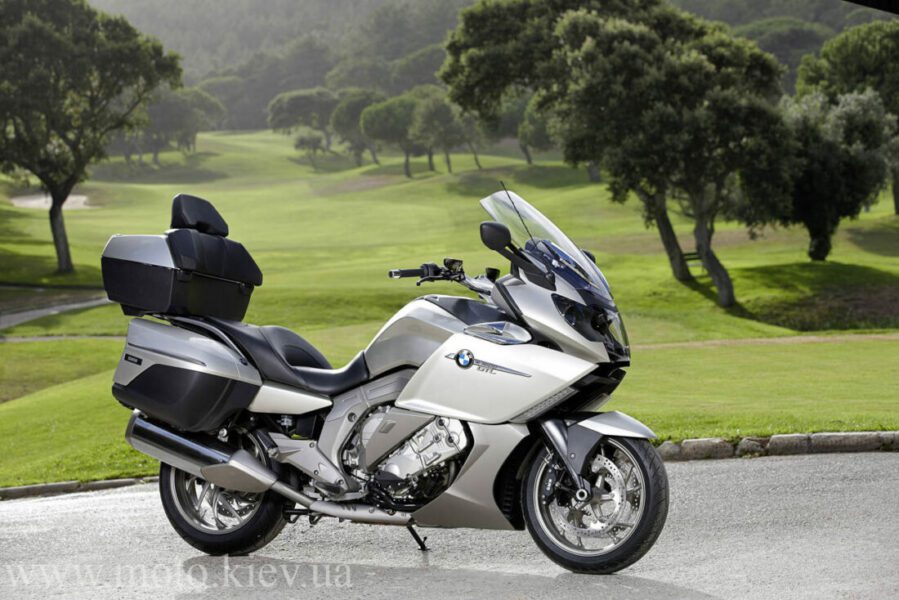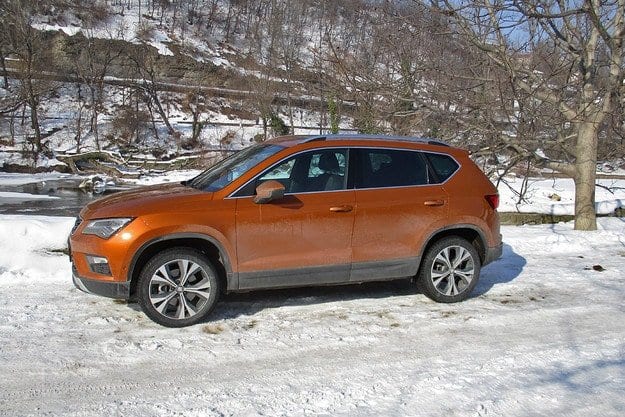
Drove: BMW K 1600 GT and GTL
- Video: BMW K 1600 GTL
- Video: BMW K 1600 GT and GTL (factory video)
- Videa: Adaptive lighting working (factory video)
BMW is known for its smooth-running six-cylinder engines with good performance and pleasant sound. I forgot to ask why a six-cylinder bike wasn't developed sooner, but at the international launch they said they took the idea seriously in 2006. Then five years ago! Please don't upload the fact that the Concept6 was unveiled in Milan in 2009 as bait as a question of what is the origin of the market for six in a row. I would have said earlier that this is just heating: attention, a six-cylinder engine is coming! And it appeared first of all in two models - GT and GTL.
The difference is only in the average suitcase, which is also a comfortable back for the girl? Not at all. The shape, frame and engine are the same (almost down to the last detail), but with some of the changes they've made, we're rightfully talking about two different models, not just the base and better equipped version. The easiest way to illustrate the purpose of a single motorcycle is to compare it to our ancestors. The GT will (or already, since it is no longer in production) replace the K 1300 GT, and the GTL will (finally!) replace the already ancient K 1200 LT. They haven't done this in years, but their owners still have very good and reasonable reasons why it's better than Gold Wing. Well, not all, and it is known that it was because of the too long change of Bavarians that some moved to the Honda camp. In recent years, Gold Wing has had almost no real rival, which was also evident from the statistics of new car registrations: Gold Wing sold well in our country, both up and down in hard times. So: K 1600 GT instead of 1.300cc GT and K 1600 GTL instead of 1.200cc LT.
Let's take a closer look. The GT is a traveler, and it's not some fancy half-tone cow, but rather a somewhat sporty touring bike. With a front windshield that provides sufficient draft around the helmet in the lowest position, with an upright riding position and surprisingly lively driving performance. Understand - it weighs so many kilograms, but it is not uncomfortable, even in place, since the seat is at a very comfortable height, and therefore the soles consistently reach the floor. If you can turn the bike in the parking lot with the handlebars fully turned (with the engine, not with your feet), you (like me) will be bothered by the fact that the handlebars are almost touching the fuel tank. and therefore, with the steering wheel turned to the right, it is difficult to control the throttle lever. If I could be a little picky, I would point out the somewhat unnatural response to quick turns of the throttle lever (one gets used to it with kilometers, and this is only noticeable when starting off or turning in a parking lot) and at my 182 centimeters too far from driver's lumbar support: when I wanted to lean on this support, my arms were too extended, but I definitely felt much better on this 1.600cc GT than on the K 1300 GT.
The weight difference is very noticeable when I want to lift the GTL off the side stand. With more resistance, the steering wheel, which is closer to the driver, turns in place and therefore does not approach the fuel tank in the extreme positions, as on the GT. It sits more “cool”, with the right distance from the seat back, pedals and handlebars. It's funny how the passenger's grips are so close to the (richly dosed) seat that the foam is already pressing against the fingers. By my logic, they should be a little farther forward and about an inch taller, but I haven't tested them while driving, so the estimate may not be accurate. Let her go to the salon with you and she will tell you if it suits you or not.
Behind the wheel? I am still going through this. Imagine wide roads with rough asphalt, almost 30 degrees Celsius, a group of REM in the speakers and 160 "horses" on the right. The engine is just built for a package like the GTL. If that were the only thing left to drive the GT, I would say great, great, great, but ... The six-cylinder engine is made for the high-end traveler. At first it spins, then whistles, and at a good six thousand rpm, it suddenly changes the sound and begins to growl, which is pleasant to listen to. The sound is not comparable to the spiral thousandth cubic meters of four-cylinder engines, but it has more depth, nobility. Vvvuuuuuuuuummmm ...
The charm of such a large displacement in six cylinders is that you can serpentine in sixth gear and from just 1.000 rpm, and at high revs it offers power that propels the GTL to 220 kilometers per hour and more. And this is with a fully vertical visor! The gearbox has short movements and does not like rough commands, but soft and precise ones. With a sharp movement, the computer showed a tenth of less than seven, and in a more leisurely (but far from slow) trip, the GT consumed exactly six liters per hundred kilometers. The plant claims a consumption of 4 liters (GT) or 5 liters (GTL) at 4 km / h and 6, 90 or 5 liters at 7 km / h. This is not much.
In front of the driver on both models there is a real small information center, which is controlled by a rotating wheel on the left side of the steering wheel. It is possible to change the suspension settings (driver, passenger, luggage) and engine (road, dynamics, rain), display on-board computer data, control the radio ... The patent is not complicated at all: rotation means walking up and down, Confirmation by right-clicking, return left by clicking the main selector. Speedometers and engine rpm remain analog, and there is a (removable) touchscreen navigation device at the top of the dashboard. This is actually a Garmin device that is connected to the motorcycle and thus sends commands through the sound system. But you know how nice it is when a lady in the extreme south of Africa kindly warns you that you have to turn right. In Slovenian. Unlike the dashboard with good contrast, the sun navigation screen is less visible at the rear.
The wind protection is so good that the vents on the trousers and jacket barely served their purpose, but the Germans came up with such cases: on the side of the radiator grill there are two flaps that are turned outward (manually, not electrically). and thus the air flows around the body. Simple and useful.
There are many more notes in the two days of driving, and there is so little space and time. Maybe something else: unfortunately we didn’t drive at night, so honestly I don’t know if this devil really shines in the corner. But someone near me already has it, and he says that this technique works wonders. At the moment this is so, and we promise to conduct tests on domestic logs as soon as the first samples arrive in Slovenia.
NOT like a Triumph!
The design lines carry a significant part of the sporting message. Pay attention to the mask separated from the side plastic - a similar solution was used in the sporty S 1000 RR. Otherwise, the lines keep the bike long, sleek and low.
It can be seen that they meant good wind protection for the driver and passenger, since all surfaces from the front were slightly bent. When asked what problems they had in combining the relatively wide engine into a coherent whole, David Robb, vice president of the development group, said that the engine was partially used for wind protection.
Namely, they wanted to leave it visible to the eye so that the side line (as seen from the floor plan) would also pass directly through the first and sixth cylinders. With a simple sketch on the back of the business card, Mr. Robb quickly explained why the GT's mask doesn't even look like the one on the Triumph Sprint. I admit that after the publication of the first photos, I noticed some similarities, but in fact, the masks of the Englishman and the German are not similar.
Matevж Hribar, photo: BMW, Matevж Hribar
First impression
Appearance 5
Finished. Elegant, slightly sporty, full of aerodynamic details. He is liked by a wide audience, including non-celebrities. This is especially difficult when the lights are on at dusk.
Motor 5
Extremely full of torque on acceleration and on serpentines, almost incredibly strong at maximum revs. There is no vibration or it can be compared to shaking a glass with a drowning bee. Throttle lever response is a bit slow and unnatural.
Comfort 5
Probably the best wind protection in the world of motorsport, comfortable and spacious seat, quality gear. In particular, older motorcyclists are comfortable with both.
Sena 3
Maybe someone, judging by the launch price of the S 1000 RR, thought the GT and GTL would be cheaper, but the figure is quite correct. Expect to increase the amount with accessories.
First class 5
In the case of automobiles, such a statement is difficult to write without hesitation, but there is no doubt that a world on two wheels is undeniable: BMW has set the standard in the world of touring motorcycles.
Price for the Slovenian market:
K 1600 GT 21.000 euros
K 1600 GTL 22.950 euros
Technical data for the K 1600 GT (K 1600 GTL)
engine: in-line six-cylinder, four-stroke, liquid-cooled, 1.649 cc? , electronic fuel injection? 52.
Maximum power: 118 kW (160, 5) pri 7.750 / min.
Maximum torque: 175 Nm @ 5.250 rpm
Energy transfer: hydraulic clutch, 6-speed gearbox, propeller shaft.
Frame: light cast iron.
brakes: two coils ahead? 320mm, 320-rod radial jaws, rear disc? XNUMX mm, two-piston.
Suspension: front double wishbone, 115mm travel, rear single swing arm, single shock, 135mm travel.
Tires: 120/70 ZR 17, 190/55 ZR 17.
Seat height from ground: 810-830 (750) *.
Fuel tank: 24 L (26 L).
Wheelbase: 1.618 mm.
Weight: 319 kg (348 kg) **.
Representative: BMW Motorrad Slovenia.
* GT: 780/800, 750 and 780 mm
GTL: 780, 780/800, 810/830 mm
** Ready to drive, with 90% fuel; information is applicable without GTL suitcases and with GTL suitcases.
